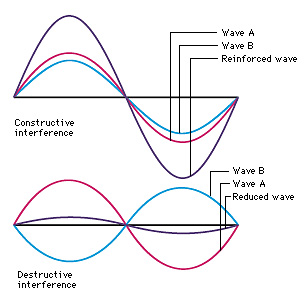Interference is an effect caused by two waves of the same kind passing through the same space. It occurs with all kinds of waves, including sound waves, light waves, radio waves, and water waves. Interference causes the intensity of waves to be stronger in some locations than in others. The term interference also refers to any overlapping of radio and television signals with unwanted electromagnetic waves.

The interference of sound waves can be demonstrated with two speakers connected to the same source of sound. If a listener is sitting at the same distance from both speakers, the crests of the two sound waves reach the listener simultaneously. The waves arrive in phase with each other–that is, the crests of the two waves and their low points coincide. As a result, the sound heard by the listener is four times louder than that produced by either speaker alone. This effect is called constructive interference.
If the listener were to sit closer to one speaker than the other, the crests of the two sound waves would reach the listener at different times. The waves might then arrive out of phase. If they arrived exactly half a cycle out of phase, the crests of one wave would coincide with the low points of the other. The waves would cancel each other, and so no sound would be audible to the listener. This effect is known as cancellation or destructive interference.
Similar interference occurs with light waves. The effects can be observed in a simple experiment. Coat a glass plate with paint and then scratch two thin lines very close together. Direct a beam of light at the lines and allow the emerging light to fall on a viewing screen. The light appears as a series of colored bands called interference fringes. Each band will have bright and dark fringes. The bright fringes are areas where light waves from the lines arrive in phase and reinforce each other. The dark fringes correspond to areas where the waves arrive out of phase and cancel each other.
Research on interference has helped scientists understand the wave nature of light and the structure of atoms and molecules. It also has resulted in various practical applications. For example, the interference of light waves aids the production of three-dimensional images called holograms (see Holography ). It is also used to control radio transmission and reception. Radio stations sometimes beam radio waves from several antennas in a row. The resulting interference pattern increases or decreases the signal intensity in certain directions. Similarly, radar waves may be sent in varying phases from different antennas. The resulting interference enables radars to spread signals in many directions without moving.
